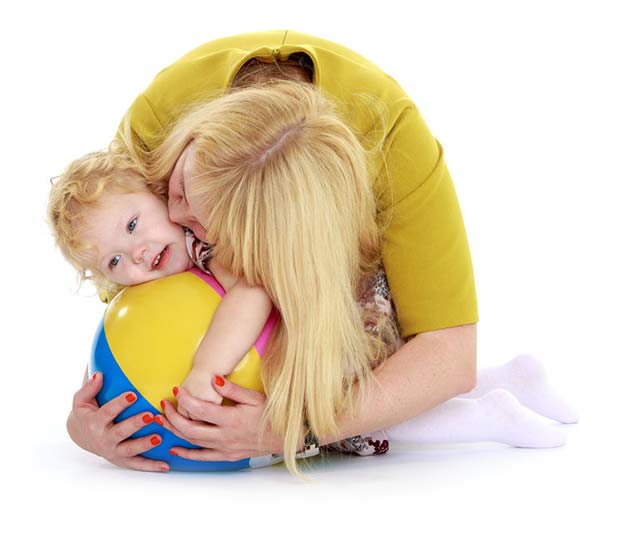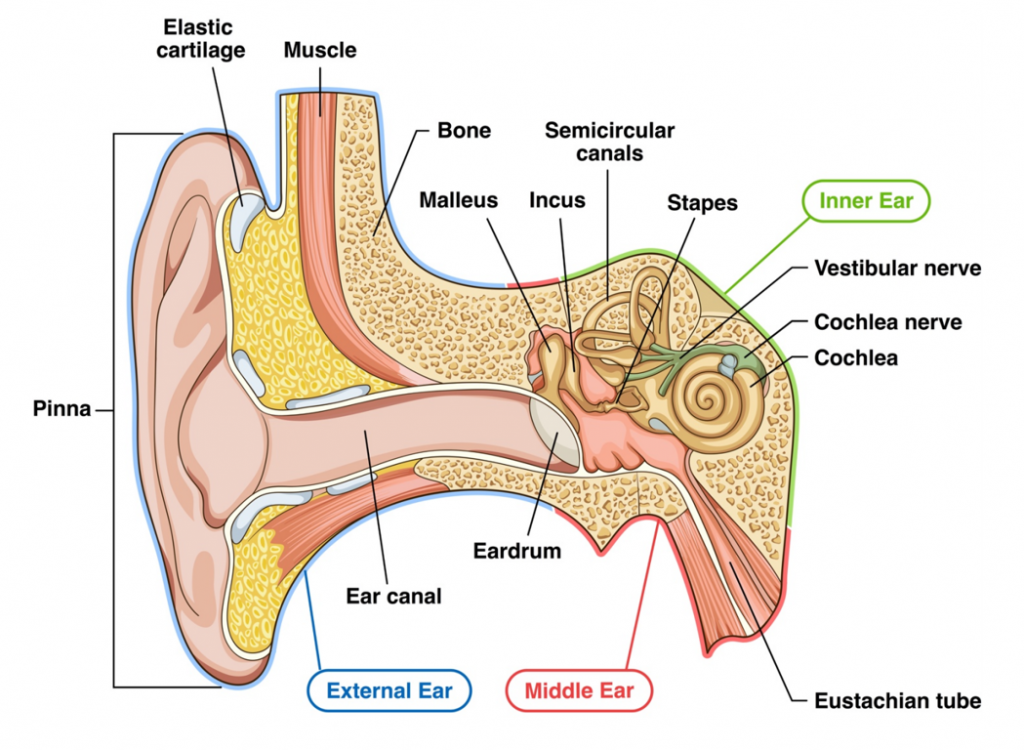
Being Deaf or Hard of Hearing
We hear with our brain. Our ear is a sophisticated messenger that delivers sound to our brain that then makes sense of the information.
The ear is not only the shell you see on the outside. It is arranged into three parts. These are called the outer ear; the middle ear; and the inner ear. Each of these parts has a different role to play in transporting sound to the brain.
The degree of hearing loss
There are varying degrees of hearing loss; 4 official categories, descending in severity. They are mild, moderate, severe and profound. The following classifications describe the effects on hearing ability.
A decibel (dB) indicates the loudness or intensity of a sound. A whisper is about 20dB, ringing telephone is around 65dB and a jet engine taking off is about 150dB.

What do Hearing & Hearing Loss mean?
- Mild Hearing loss (21–40dB): If your baby has a mild hearing loss they will have trouble hearing at playgroup or family gatherings, even though they can often manage quite well in quiet situations.
- Moderate hearing loss (41–60dB): If your baby has a moderate hearing loss it is very hard for them to understand what you are saying, especially in background noise. Hearing aids will assist hearing ability.
- Severe hearing loss (61–90dB): If your baby has severe hearing loss they cannot hear normal conversation and so they will not learn to speak naturally by themselves. Hearing aids will assist hearing ability and sign language skills may assist in communication.
- Profound hearing loss (91dB+): If your baby has a profound hearing loss they would need considerable assistance to hear talking and noises. There are specialised hearing aids, designed specifically for larger hearing losses that do just that. Also the option of having a device called a cochlear implant to further support enough access to speech sounds is available. Although spoken communication is more common with a cochlear implant, research has shown sign language to be very beneficial to assist understanding and cognition.
PLEASE NOTE: Hearing aids and/or cochlear implants assist the ear to hear sounds and send them to the brain. However, it is through early intervention services that parents and the child access the support needed to assist the child’s brain to make sense of sounds. This supports communication development.
Types of hearing loss
Sensorineural hearing loss (SNHL) A diagnosis of SNHL means the hearing loss is of a permanent nature. “Sensorineural” refers to problems with either the cochlea (sensory hearing loss) and/or the auditory nerve (neural hearing loss). It can be present at birth (congenital), through birth complications, or acquired after birth. It may be acquired from a serious infection such as meningitis or mumps; from certain medications; or in many cases, the cause is unknown. There is poor function in the part of the inner ear called the cochlea in one or both ears. The function of the hearing nerve can also be affected. Your baby at this point can be referred to an Ear Nose and Throat Specialist (ENT). The ENT Specialist, as part of their investigations, may refer your child to a variety of other professionals e.g. Geneticist, Ophthalmologist or request further tests e.g. MRI scan, CT scan. It is likely that the audiology organisation you are attending will refer you to Australian Hearing to assess the suitability of hearing aids for your baby.
A hearing review is usually carried out after 3 months by the Australian Hearing’s Paediatric Audiologist to see if there have been any changes to your baby’s hearing loss. It is at this point an assessment will be made as to the benefit your baby has had as a result of using hearing aids. Other options may be investigated if appropriate e.g. cochlear implants or other surgical procedures; learning sign language as part of bilingual communication.
Unilateral/Single sided (one ear) SNHL A unilateral hearing loss affects only one ear. It can range from very mild to total hearing loss on the affected side. There is increasing recognition of the potential impact of a unilateral hearing loss and it should not be underestimated with regards to the development of language and communication Children with unilateral hearing loss can have difficulty with:
- Hearing in noisy surroundings
- Locating where sound is coming from
- Hearing when sound is on the same side as the affected ear
- Communicating in noisy or multi-speaker/multi-directional (group) conversation
- Social participation
- Speech and language development.
Whilst not every child will have problems with language development, some children may miss being fully included in everyday conversation. To minimise the risk of missing this important incidental language learning, children and their conversation partners, including family and friends, should make sure they get the other person’s visual attention before and whilst speaking.
Bilateral (both ears) SNHL Bilateral hearing loss is any degree of permanent hearing loss that affects both ears.
Children with bilateral hearing loss can have difficulty with:
- Hearing quiet or loud sounds
- Differentiating between similar sounds
- Speech and language development
- Hearing speech when there is background noise
Conductive hearing loss (CHL) Conductive hearing loss is usually temporary in nature and means there is a disruption to the way sound waves are carried through the middle ear to the inner ear. It may be the result of an infection and causes hearing to be muffled. If it is likely your child has CHL, he/she will be referred to your General Practioner (GP) for treatment and monitoring. A follow up hearing test will be carried out a few months later. If normal hearing thresholds are obtained no further treatment is required. Some examples of temporary conductive hearing loss are:
- Blockage of the ear canal with wax
- Otitis Media (middle ear infection) and/or fluid build-up (glue ear)
- Perforated eardrums In rare cases, conductive loss may be permanent.
In rare cases, conductive loss may be permanent. A child may also have both a conductive loss and a sensorineural loss. Your paediatric Audiologist is able to tease out the likely site of the hearing problem and will refer you to the most appropriate professional(s). In this situation you will be referred to an Ear Nose and Throat Specialist (ENT). Your Paediatric Audiologist may refer you to Hearing Australia for hearing aid fitting.
Causes of conductive hearing loss
Otitis Media: Otitis media is caused by a virus or bacteria that leads to a build-up of fluid behind the eardrum in the middle ear. This condition can result from a cold, allergy or respiratory infection. The accumulation of fluid in the ear may cause ear ache pain, swelling and redness, discharge and prevent the eardrum from vibrating properly. Mild cases of middle ear infection often resolve of their own accord. More persistent cases may need medical attention and antibiotic treatment. It may be necessary for your GP to refer you to an Ear Nose and Throat Specialist (ENT). Sometimes if the build-up of fluid lasts for long periods of time a condition called glue ear may develop. In some of these cases an ENT Specialist may decide to insert ventilation tubes (grommets).
Treatment of conductive hearing loss
What is a grommet? A grommet is a tiny tube inserted into the eardrum under general anaesthetic. It allows air to enter the middle ear space to prevent the accumulation of fluid. This normally results in improved hearing. Grommets generally stay in the eardrum for 7–12 months and fall out on their own. Some children need more than 1 set of grommets.
Additional Disabilities
Dual sensory loss or deafblindness
The combination of hearing and vision loss is often referred to as ‘dual sensory loss’. Most children will have some degree of hearing or sight. Very few are both profoundly deaf and totally blind. The term ‘Deafblind’ is used for children who are totally blind and profoundly deaf. Some people also use this term when speaking about children who have both a significant hearing loss and a significant vision loss but may have some degree of hearing or vision. Each child will have different needs depending upon the combination of hearing and vision impairments affecting them.
